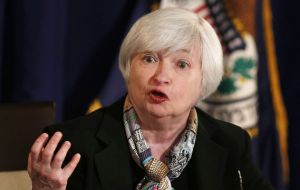MercoPress. South Atlantic News Agency
US economy grows faster in 4Q, but high inventories could impact 1Q of 2016
 US central bank chair Janet Yellen has indicated that rates could rise gradually through the year if the economy grows strongly enough.
US central bank chair Janet Yellen has indicated that rates could rise gradually through the year if the economy grows strongly enough. The United States economy grew at a faster pace than previously thought in the fourth quarter of 2015, according to the latest official figures. Growth was an annualized 1% in the quarter, compared with an initial estimate of 0.7%.
Most economists had taken a more pessimistic view, expecting the figure would be revised downwards. But businesses bought more stock than previously estimated, which meant inventory levels were $13bn higher.
The downside is that next month's growth figures may be lower than expected if businesses do get round to cutting back on inventory spending. Some forecasts put the growth rate for the first three months of 2016 as high as 2.5%.
Chris Williamson, chief economist at research firm Markit, said: “Unfortunately, the cause of the upward revision bodes ill for the first quarter.
”The GDP number was revised higher in part due to a bigger than previously thought contribution from inventories, something which often happens due to weaker than expected demand, meaning inventories could act as a drag in the first quarter as excess stocks levels are wound down again.“
Consumer spending, which accounts for more than two-thirds of US economic activity, rose at a 2% pace in the fourth quarter, rather than the 2.2% rate previously estimated.
Cheap oil and lower heating bills from a mild winter has helped consumer confidence. But some economists fear that the slowdown in consumer spending could get worse.
Williamson said: ”Companies cite a number of worries that are dragging on customer spending and causing business to become more risk averse. These include uncertainty about the forthcoming election, financial market volatility, the global economic environment and the possibility of higher interest rates.”
The chair of the US central bank, the Federal Reserve, Janet Yellen has indicated that rates could rise gradually through the year if the economy grows strongly enough.
However, many economists believe US growth will be held back by slowing economies round the world from China to Brazil, pushing down the prices of raw materials and leading to deflation.
For example, lower oil prices have been a drag on the profits of oil companies and a range of oil support industries, leading them to cut spending on investment.




Top Comments
Disclaimer & comment rules-

-

Read all commentsIn a few years this country will undergo a social disruption that will cause the US division in several different countries.
Mar 01st, 2016 - 12:59 pm 0https://www.youtube.com/watch?v=cv-pTU99RcY
So?
Mar 03rd, 2016 - 09:41 am 0Instead of one country exceeding Brazil is most measures, you'll just have several doing the exact same thing.
Commenting for this story is now closed.
If you have a Facebook account, become a fan and comment on our Facebook Page!